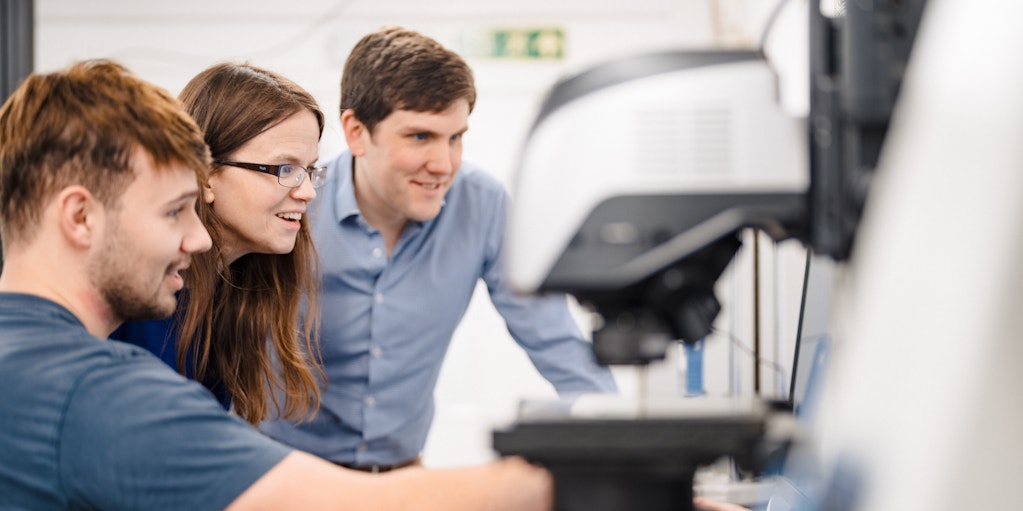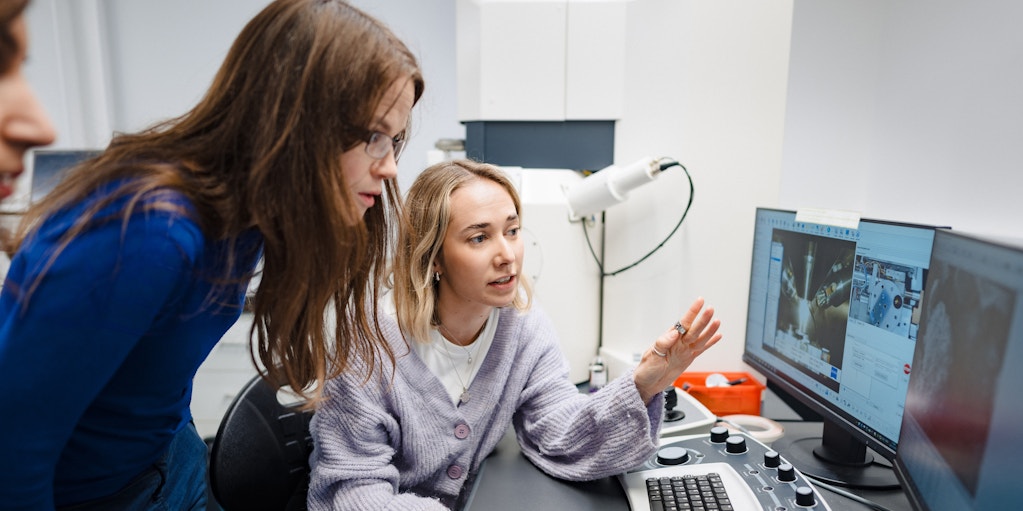
15 minutes with: Caren Lacy
Tags
Our experts are on the frontlines of bringing ingenuity to life for our clients. They accelerate new growth ideas from concept, through design and development to commercial success. And they revitalise organisations with the leadership, culture, systems and processes to make innovation a reality.
In this series, you’ll meet some of the brilliant minds creating change every day.

What is your professional background and how did you come to PA?
I’m a physicist – I studied at Manchester University, and have a Masters degree in physics and astrophysics and a PhD in fluid dynamics. I also worked as a R&D engineer, at a start-up, and later as a post-doctorate researcher. The work was very hands-on and experimental, and there were always many new avenues to explore at great depth, often on my own.
The work made me realise that what I really wanted were tricky problems to solve, a timebox to solve them in, and a team to collaborate with to find a solution. So, I joined a startup consultancy in the energy space. It was very much a baptism of fire, but it gave me the skills to succeed at a larger consultancy. When I looked around the bigger consultancies, I felt that the outputs were quite generic. I really wanted to work somewhere with a strong foundation in science with people who had a deep understanding of their subjects – and PA had that. I sent LinkedIn messages to two people at PA and they both got back to me. I was introduced to Andrew Burrows at PA’s Global Innovation and Technology Centre, who told me about PA’s technology innovation and development work, and I knew it was the right place for me.
How would you describe what you do to someone who isn’t familiar with the world of consulting?
When I explain my job to my seven year old, I say I help companies make the world less polluted while growing their business and employing more people so they can have happy lives with enough income. It’s a balance of making the world greener, but also building the economy.
A slightly more technical explanation is that we are helping companies understand the energy transition and how they can operate in it and develop and scale up their green technologies quickly. This might be a traditional energy company trying to understand the threshold for change and cut through the hype to make the right investment decisions for their business, a company already in the renewable space wanting to grow, or a company that needs help with testing, developing, and scaling its technology – and bringing it to market.
We help them focus on the right technologies and understand the risks from a technological, regulatory, and market perspective, and can help them to develop and scale new leading-edge technologies fast. Together with their teams, we help our clients to navigate the complexity based on science and fact.
Would you say that your work is driven by purpose?
It’s really important that what we do is ethical and makes a positive difference in the world. We’ve turned away projects with questionable scientific merit, or no tangible positive good.
The work we do in our energy and utilities practice is very well aligned with this purpose – we are working on many green energy projects including within hydrogen and its derivatives, which is my specialism, but also in electrification, water, and carbon capture.”
These are very complex, interesting areas where a lot can go wrong but where there’s huge opportunity to make a real, positive impact on the world. For example, as the deployment of solar power and offshore wind accelerates, large-scale energy storage is becoming an important requirement to help our electricity grids deal with the varying power outputs from these sources. Hydrogen can play a role in seasonal energy storage there, alongside other storage technologies for shorter duration storage. However, both technology and economics are quite challenging, and have to be considered carefully as part of a wider system. There’s plenty of space for technology innovation to improve these systems and support the energy transition as a result.
What have been the biggest changes or developments in your work in recent years?
When I first started focusing more on the hydrogen space a few years ago, companies were mostly tentative, putting out feelers. Now, the discussion has moved from whether to invest into hydrogen at all to how to successfully deliver actual projects and related infrastructure. They are asking questions such as: how can we develop and scale up our technologies? How can we win government funding for our projects or technology development? What are the right technologies for the most efficient plant? Where are the risks? Which regulations are relevant? How can we make the economics work? Which start-ups should we invest in? The maturity of thinking is changing, and there are now a lot of exciting pilot projects coming off the ground and new technologies being developed.

It’s important to note that hydrogen has been around for a while. Some companies in the energy industry have experienced a hydrogen bubble in the past which burst for many reasons. But now this will be different provided we make the right decisions. We must not overhype what hydrogen can do, and take care to fully understand the topic. Hydrogen and its derivatives can play a very important role in the energy transition, and we shouldn’t sabotage that role by thinking of it in the wrong way. It’s not a solution for everything. It’s an important tool for specific applications, which will also depend on the context. That is why it’s important to get things right.
Technologies and projects are being developed that will be market-ready in two to three years. How well these perform will have an important influence on how the space will develop in the future. It’s a very exciting space.
What are you most excited by right now in your industry?
I’m most excited about the technology innovation. Lots of technologies are involved in the hydrogen space, such as electrolysers, compressors, fuel cells, hydrogen storage solutions, and hydrogen sensors. Plenty of startups are developing new technologies in that space, and for me as a scientist, that is of course very exciting. For example, one company is developing a new electrolyser with a completely novel design to improve the efficiency and reduce cost.
Others are working on innovations in specific electrolyser components, like developing thinner membranes. Others are working on reducing the amount of expensive and rare materials used in making key components. That’s quite important because the availability of some materials currently used in electrolysers, like iridium, is very limited, so we must find ways to reduce their use or replace them with more abundant materials – but that is not necessarily simple.

There are significant technology challenges with hydrogen storage too, which are being tackled. Hydrogen is energy dense by weight, but not by volume – it is a very light gas. To transport it to where it is needed, or to use it to fuel a ship or vehicle, you need to compress or liquify it to make that more technically and economically viable, which costs a lot of energy.
Some very interesting technologies are being developed as a potential solution, such as metal–organic frameworks (MOFs). These are a special group of materials that act a bit like a sponge for hydrogen. But rather than squeezing them to get the hydrogen out, you change the temperature or pressure. The tricky thing is to make that sponge only store hydrogen and not other things, and store as much of it as possible, and also to produce these materials at scale and at the right cost. You can also transport hydrogen by pipeline of course, but you need to produce and use a lot of hydrogen for that to be feasible.
Several countries are planning hydrogen pipeline networks, such as the European Hydrogen Backbone, and it will be interesting to see how these large-scale projects will develop. It’s a huge undertaking.
The technologies involved in using hydrogen to make low carbon fuels are also very exciting. For sustainable aviation fuels, for example, there are lots of different production pathways all using different feedstocks.”
One of them is to use hydrogen and carbon dioxide that has been captured from a chimney of a factory and purified. You can also use direct air capture, where you remove carbon dioxide from the outside air, and that’s energy intensive compared to getting carbon from a direct source, like a chimney. There is a lot of research and development going into making this more energy efficient, and that is something we are also involved in at PA. To get to the fuel once you have your hydrogen and carbon, you need conversion technologies. Lots of work is going into scaling these up and bringing down the costs. Then we will need to understand the true efficiency of such systems once they are actually up and running, and improve the design.
This is what’s exciting to me – getting to work on these complex cutting-edge technology challenges and having the chance to be there to see some first-of-a-kind projects from the very start to the finish. It will be absolutely fascinating to have the chance to be part of developing key technologies and to see the actual performance of technologies in the field and then work out how to improve and optimise them further. Seeing how hydrogen and hydrogen derivatives help decarbonisation will be fascinating too of course. After all, the proof of the pudding is in the eating.
How would you say that you bring ingenuity to your work to solve these complex challenges?
It’s about seeing the bigger picture, working with people with the right knowledge and expertise, and linking all the strands together through lateral thinking. To be efficient in your delivery you also need to avoid reinventing the wheel. This means understanding where similar problems have already been solved. Where can we transfer solutions? What can we learn from other industries?
It’s very important to be up to date beyond your own niche, and be aware of the energy transition more broadly, including technology development across the board. That is true for when you are trying to develop technology solutions, but also if you are advising on decarbonisation options more broadly, especially if there are solutions out there that are better than hydrogen for a given application. This goes back to my point of choosing the right applications for hydrogen.

What sets PA apart from other consultancies, and how is our approach different?
It’s really our diversity of skills. Within our Global Innovation and Technology Centre, we’ve got chemists, chemical engineers, material scientists, physicists, mechanical engineers, biologists, electrical engineers, and more. This is what’s needed to tackle the energy transition. We’ve got chemical engineers and material scientists who look at MOFs for hydrogen storage, for example, and some of our mechanical engineers, chemists, chemical engineers, and physicists have worked together to develop some exciting carbon capture technologies and helped to improve an ammonia cracker.
We can answer technical questions around biofuels down to bioengineering of algae. Our chemists and chemical engineers can understand those challenging fuel conversion pathways we talked about earlier, like those using hydrogen and carbon to make fuel. And I even had a chance to dust off my fluid dynamics knowledge for some questions around geological hydrogen storage for one of our clients.
We also have many colleagues who are experts in energy regulation and policy, economics, growth strategy, investment and so forth – the more traditional consulting areas, who can tell you how to make the business side work. As a result of having people with all those skills, and working as one holistic team, we can answer really complex questions. With such a broad range of backgrounds, we can also transfer learning from other industries like transport and defence to the energy space and vice versa. This avoids tunnel vision and enables knowledge sharing.
That’s what makes us different – diverse skills gained in a wide range of industries. All of this allows us to deliver work that is different, impactful, and implementable, which is the most important thing.”
What are some of the most interesting projects that you’ve worked on?
A super exciting project involved co-developing a concept for an energy transition technology accelerator. This is basically a campus where startups are helped to develop new technologies for the energy transition. We scanned different technologies and selected the most unique and impactful areas – for example, hydrogen, carbon capture, and water purification technologies – and then selected specific technology areas within them to focus on. We assessed which technologies would be most impactful for decarbonisation, or for solving specific problems like water scarcity. We then had to identify the facilities required to develop and accelerate these technologies further.
It was a real team effort to develop solid, sound criteria for selecting technology areas for the accelerator to support. This included finding a way to assess the likelihood of a significant return on investment, to ensure the accelerator could keep developing solutions.
Economic viability is also an important part of our technology acceleration work – after all, to be successful, a new technology doesn’t just have to work, it has to be competitive in the market.”
Therefore when we help to develop a new technology we consider how it will be manufactured and how much that will cost, how it will be used, and what it will be competing against. We also have a very important role to play on economic viability when helping clients win government funding, for example, for hydrogen or sustainable aviation fuel plants. What I like best is when you clearly see the positive impact of our work for the client.
What would you say to somebody who wants to do what you do?
Be prepared for the fast pace, especially if you come from academia. It’s a very different way of thinking about problems. You have to focus on the application, the end goal, and the most efficient way to get there.
If you love fast-paced work, lots of diversity, and learning a lot of new things, then consulting is a great place to be.”
However, you have to be passionate about what you do because the work can be hard. You do of course also get the satisfaction of seeing the real difference that all the hard work can make – and that makes it very worthwhile.
I also would say that you should be prepared to broaden your thinking. Make sure you have got visibility of all relevant and associated areas and technologies around your own expertise. So, if you’re interested in supporting the growth of hydrogen, understand its end-use applications and be aware of other competing decarbonisation options like heat pumps, electrification generally, biofuels generally, and carbon capture. Know how hydrogen could be used in sustainable aviation fuels and what other pathways there are to produce them, and so forth. Try to understand as much as you can about the wider area you’re working in, and be open to learn and ask many, many questions.
What are your goals, professional or personal?
My goal is always to learn more. You can never know enough. Technology doesn’t stand still, so my goal is really to learn more about not just hydrogen, but all of the other areas around it too. I want to become as familiar as I can with as many energy transition technologies as I can, and also learn from colleagues on the regulatory and economic side to understand what’s driving the energy transition. Only then can I really be impactful for my clients. The more you learn the more you can identify what you don’t know (and also work out who to ask to find out the answer).
What are you looking forward to right now?
My son has decided to build a Lego Space Science Centre. I’ve promised to build it with him, so that’s going to be good fun. There are a lot of Lego buildings we’ve started, including some labs and a mobile pizza waggon.
Explore more







